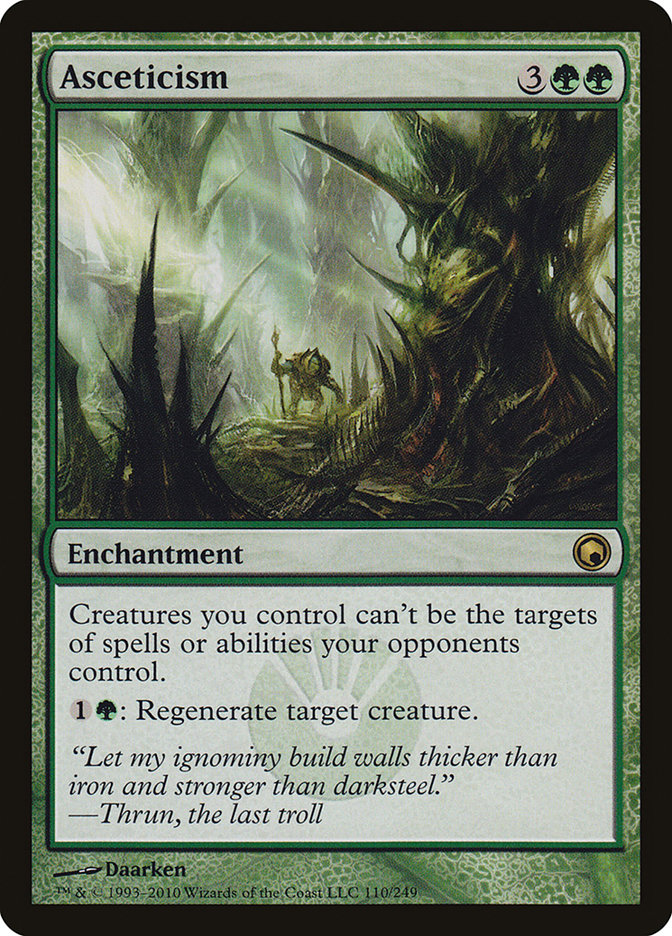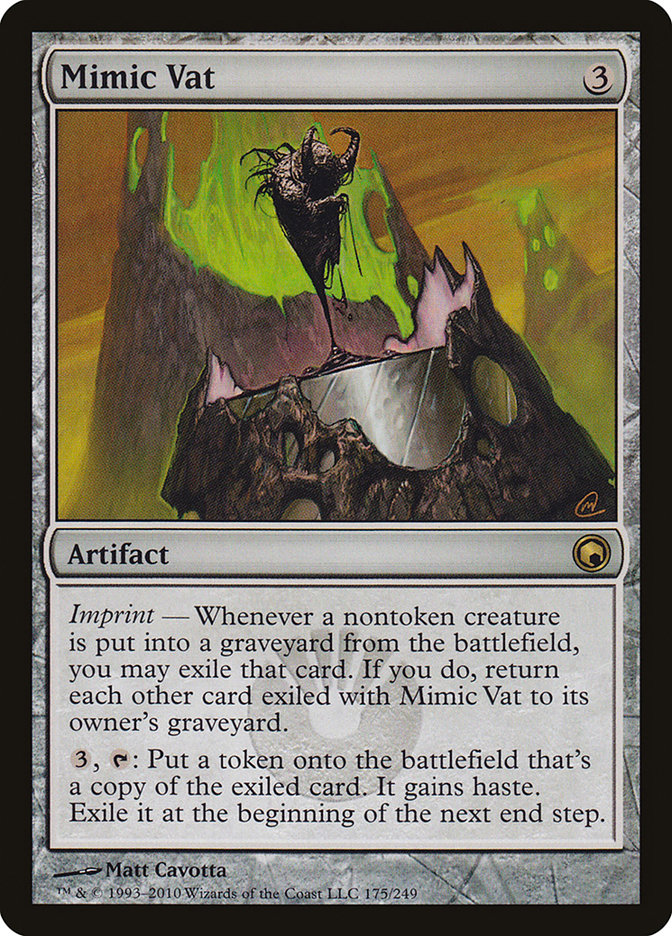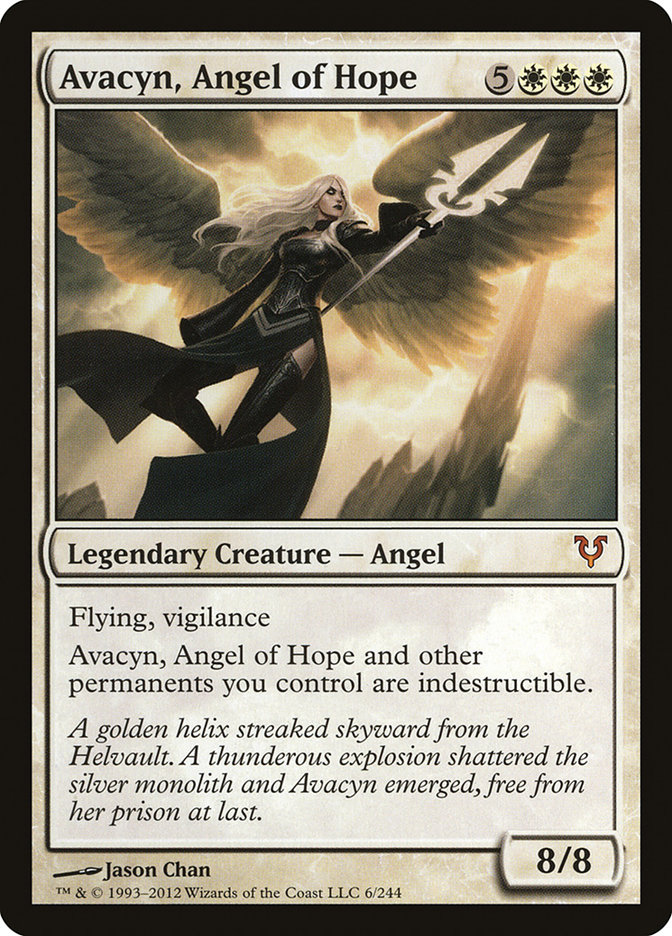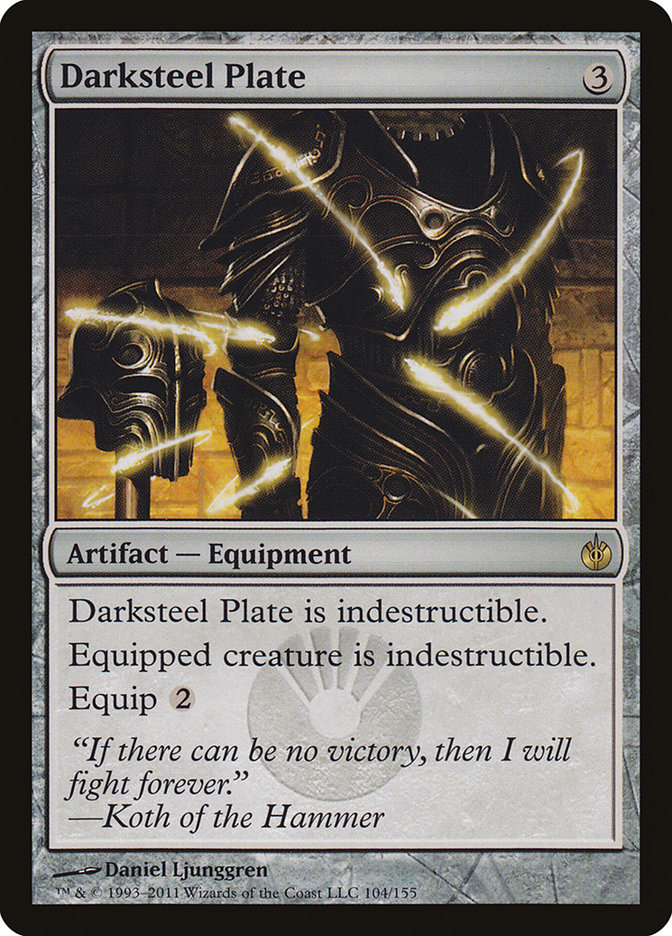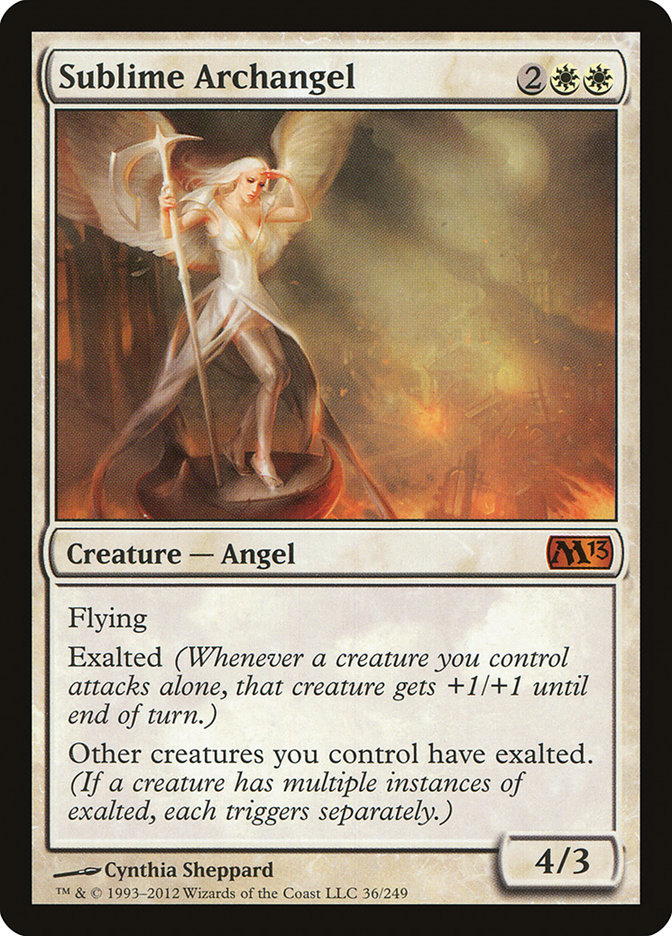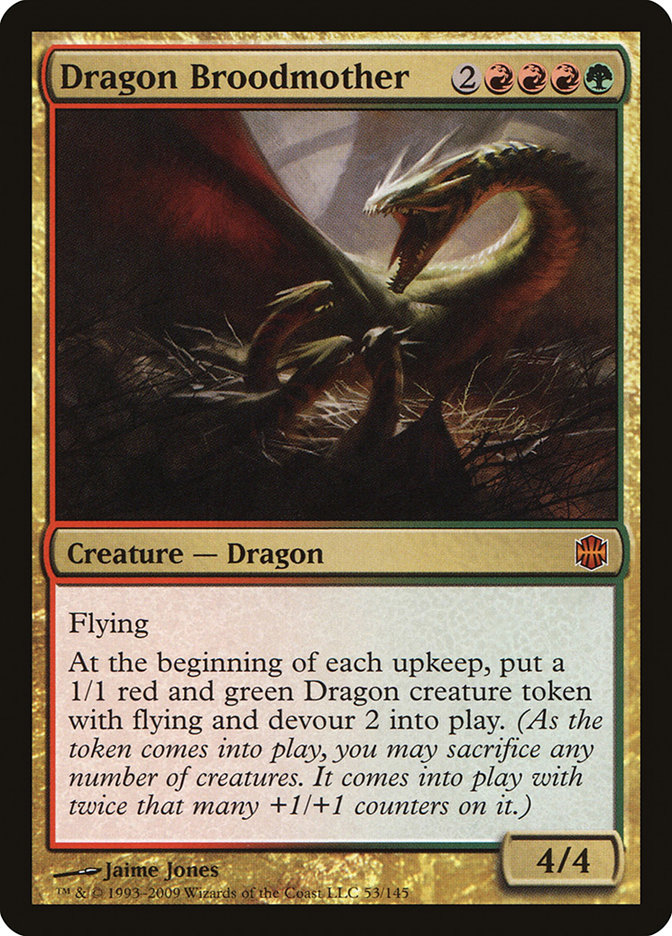Standard is the most popular Constructed Magic format by far. Back in May, a copy of Thragtusk would have set you back 25 dollars. You can pick him up now for four bucks. That’s the power of Standard rotation.
Analyzing Standard is relatively straightforward. Numbers tend to win out over time, so the best thing to do is look at the winning decklists each weekend and see what cards keep popping up. Cards that see more play tend to rise in value, while cards that see no play tend to fall. Things are trickier when a format rotates, but for most of the year it isn’t hard to figure out the ups and downs of Standard Magic.
Casual play is a far trickier beast to evaluate. Unlike Standard, casual players have theoretical access to every card ever printed. Popular formats like Commander help whittle the field down some, but even there you get a lot of variance that doesn’t exist anywhere else in the game. Financially, it’s hard to peg what causal players might want because demand is so varied. Some want combo enablers, others want foil Commanders, and many will only play with their favorite colors or tribes.
Casual players don’t always want the best cards in the formats that they play either. They’re after the cards that best fit the strategies that they want to try out. This leads to frustrating price discrepancies like this one:
Asceticism sells for $4 and is considered a casual staple. The card is very popular and easy to trade.
Mimic Vat is a better card from the same set as Asceticism, yet it costs a good deal less—$1.50 as opposed to $4. While Asceticism can only go into a green deck, Mimic Vat is an artifact that can slot in anywhere. It plays perfectly with the sorts of creatures that casual decks like to run anyway and only gets better with the Primordials running around the Commander-verse. For whatever reason, though, this card is significantly harder to trade and has only recently started coming up from near-bulk prices.
Is there any rhyme or reason to what becomes a casual hit? Should you be looking for the next Asceticism in Theros or waiting until rotation? Is an increased amount of casual attention driving the price of some of today’s hottest mythics? Let’s find out.
Things That Casual Players Like
Avacyn, Angel of Hope has seen play in approximately zero percent of Standard, Modern, and Legacy decks. This is her price chart over the past year, courtesy of MTGIndex.com:
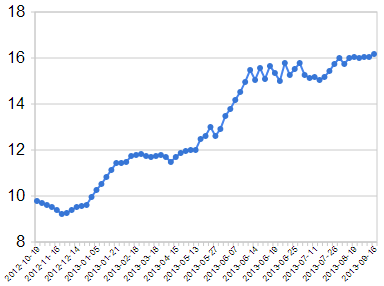
Here is the same chart for Griselbrand, a mythic from the same set that saw some play in Standard, Legacy, and Modern and will likely continue to be a fringe player in Eternal formats for years to come. Griselbrand is banned in Commander.
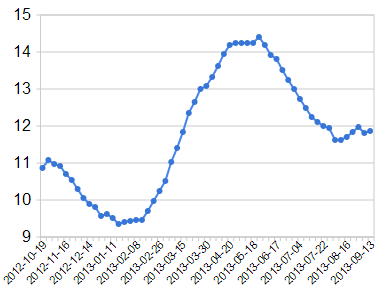
What does this tell us? First, I think that there’s some casual love still built into Griselbrand’s price, and I actually like both of these cards as soft buys right now. Mono-black ramp strategies are beloved in 60-card casual circles, and that’s one of the reasons that Phyrexian Obliterator still retails at $15.
Demand for Avacyn is much higher, though, thanks to both her Commander legality and confluence of amazing casual abilities and tribal status.
Most casual players really, really hate getting their things killed. Because of that, cards that protect your board while offering some degree of upside tend to trade well in these circles. That’s why Asceticism and Darksteel Plate are so popular and part of what makes Avacyn so appealing.
If you’re a competitive player and don’t understand this impulse, allow me to explain. Multiplayer Magic tends not to have aggro decks as you know them—it’s too hard to take out two or three players with a volley of Lightning Bolts and 2/1s for one. The fast decks in Commander tend to use some kind of combo or ramp-into-mana-denial strategy to go infinite early on or lock everyone else out of the game.
Nearly every other deck in the format is built to try to go over the top of all the others. Everyone is trying to build the biggest resilient threat, largest unkillable army, or simply a board position that can stand firm the longest. When all of your fights go long and every threat is massive, making your stuff hard to kill gives you a major advantage. It also helps prevent you from suffering collateral damage at the hands of stray removal spells.
The fact that Avacyn is an Angel is a big deal too. It used to be that all Angels, Dragons, Elves, and Slivers held a premium over identical creatures without those types. Of course, back then there were only one or two Angels or Dragons released each year, and they were special. Nowadays, almost every set has at least a couple of each. Because of that, the "low level" Angels and Dragons—your Herald of Wars and Archwing Dragons—don’t hold any kind of premium at all.
The marquee Angels and Dragons, on the other hand, still hold additional value based on their creature type. Sublime Archangel held her value for months due to her type, and Archangel of Thune’s price is still outstripping her playability for the same reason. The addition of Kaalia in Commander’s Arsenal helped bolster both of these tribes as well.
Elves haven’t fared as well in the switch from 60-card casual to Commander. While the tribe still works well in the larger format—my ten-ticket Ezuri deck on Magic Online has a lifetime win percentage of 90% or better—it’s much harder to kill an entire table at once. I built my deck for 1v1 duels, and the fact is that most Commander matches are multiplayer battles. Elves simply don’t command the same premium over non-Elves that they once did.
Slivers are interesting. The new ones have never traded well, and the casual demand that most people expected to materialize never actually did. I also expected some of the old Slivers to jump in price as people ran to make decks, but that didn’t happen much at all. It’s possible that the M14 Slivers are great long-term buys right now, but it’s equally possible that today’s casual players simply don’t care as much about that tribe—we’re fifteen years removed from the first batch after all. Proceed at your own risk.
What other things do casual players like more than competitive mages?
- Life gain. Ajani’s Pridemate is more expensive than most of the rares in M11 now.
- Mill. Glimpse the Unthinkable is nearly unplayable in Commander and is still a $20 card thanks to 60-card casual mages.
- Token generation and counters. Doubling Season and Parallel Lives both trade very well.
- Big mana ramp. Think Cabal Coffers, Mana Reflection, Gauntlet of Power, and Caged Sun.
- Planeswalkers. These cards always hold a premium higher than their raw playability. I expect the Gods will behave similarly.
- Two-way threats. Creatures like Woodfall Primus that play defense (killing a nonland permanent) while also being capable of finishing a game on their own.
- The biggest and best of everything. Whatever the "best" at something is—regardless of mana cost—will always have some casual demand. Omniscience. Vindicate. The Eldrazi titans.
Most people are already aware of these predilections and are good at pegging the cards that casual players will end up liking the most. It isn’t quite that simple though. Why is Breaking // Entering a $0.75 card if Glimpse the Unthinkable is $20? Why do I think that Prophet of Kuphrix the best casual card in Theros, yet I still recommend selling it hard right now? It all comes back to supply and demand.
Saturation Points
Avacyn started high, stabilized high, and just kept rising. There was never a great time to buy in cheap—the number of people who wanted copies of Avacyn always outnumbered the amount of cards to go around.
This is an exception to the rule these days. For the most part, there are weeks or even months where speculators have a chance to buy in on cards that will hold casual value for years to come.
For Parallel Lives, you had approximately eight months from January 2012 through August of 2012 before it started climbing up again once Innistrad went out of print.
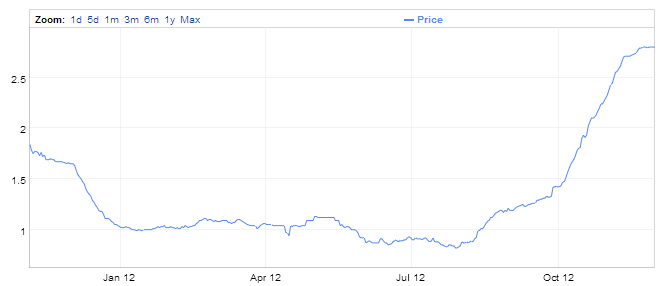
Lord of Extinction stayed low through rotation and didn’t begin to regain value until the winter after the set had already left Standard.
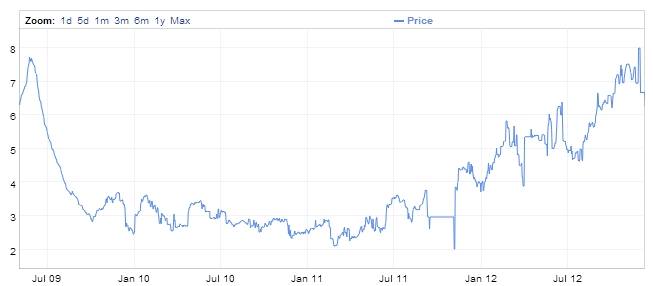
Kozilek, Butcher of Truth did roughly the same thing.
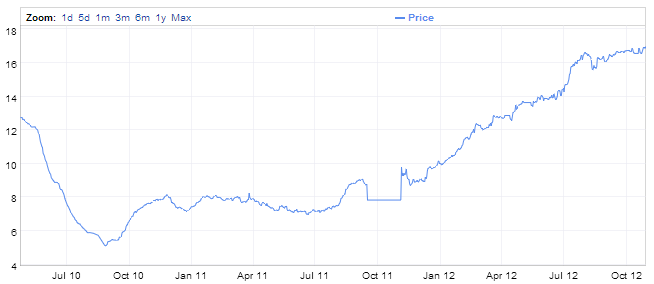
As you can see, Standard rotation didn’t hurt these cards—it helped them. Whether or not a casual card started to make a move one year after release or two years later, what mattered wasn’t tournament legality but a lack of availability.
In tournament play, the "demand" side of the "supply and demand" equation is paramount. Supply matters early in a set’s release because there aren’t many copies out there yet, but as a set matures, prices go up and down mostly based on increases and decreases in demand. There are far more copies of Desecration Demon out there than Angel of Serenity right now, but the Demon is worth more because it sees more play.
On the casual side, supply matters more. Unless a new format is invented, a new strategy is popularized, or a card is obsoleted by something newer, demand for casual cards is going to be roughly constant. Newer, shinier cards are always going to be in a little more demand, but if you want a copy of Parallel Lives for your token deck, it’s not going to matter if Innistrad is brand new or five years out of print—nothing else will suffice. Instead of card values fluctuating based on waves of demand, casual cards tend to be at their lowest when the market is the most saturated with them, and they’ll steadily start gaining once the set goes out of print.
What stops a casual card from rising in price forever? Some of them do. Emrakul, the Aeons Torn is $40 right now, and that’s on casual play as much as it is on Legacy demand—imagine the price if it weren’t banned in Commander! That’s because there’s no substitute for Emrakul—if you want to build an Eldrazi deck, you’re going to need them regardless. Most casual cards don’t gain value infinitely though. They find some equilibrium point where casual players are simply unwilling to pay any more for that particular spell. One of the liberating things about casual formats is that you can do that—in competitive formats, you can’t sub in basics for dual lands and expect to win nearly as many games. At the kitchen table, there are always creative solutions, many of which are far cheaper.
Other times, WotC simply decides to saturate the market by reprinting a beloved spell. Take a look at this price chart for Gilded Lotus:
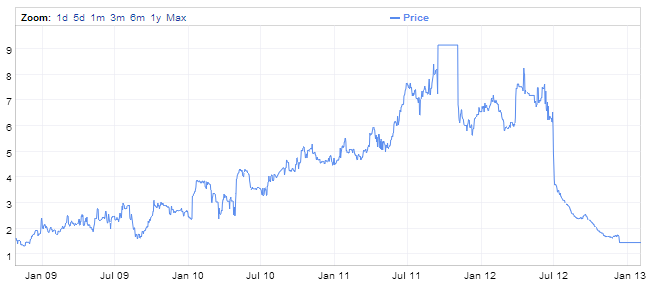
See that big plunge? That’s the damage that the M13 printing did to the card’s value. It hasn’t recovered either—you can still pick it up on StarCityGames.com for under $3. The same is true for casual hits in Modern Masters—Adarkar Valkyrie was up over $10, and now it’s under $3.
This drop doesn’t always have to be permanent though. Sometimes it’s only enough to offset a card’s price gain for a couple of years. For example, here’s Sol Ring:
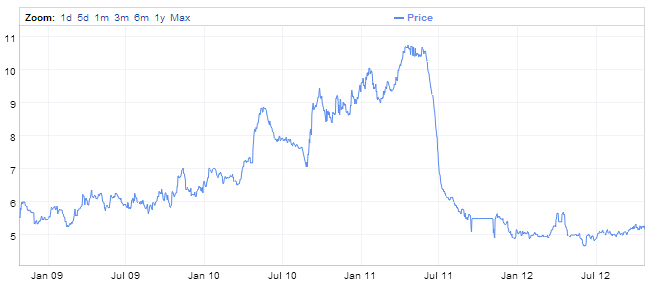
When the first set of Commander precons came out in 2011, each of them contained a Sol Ring. The card’s slow and steady gain due to the popularity of the format ceased overnight, and the card tanked big. You could pick up Sol Rings for $5 in cash or trade all day long—either version.
Today? StarCityGames.com asks $12 for Commander Sol Rings and $13 for Revised ones. So many people have started to play Commander in the past few years that the price has leapt right back up again.
What other cards might follow Sol Ring’s lead? I’ll be honest; I doubt any others will recover quite as quickly. Sol Ring is uniquely versatile and powerful in the game of Magic. There are a couple of recent cards that are worth a look or two though.
- Sanguine Bond – This card was as high as $15 at one point. It’s down under $2.
- Forge[/author]“]Darksteel [author name="Forge"]Forge[/author] – This used to sell for over $10 easily. You can get it under $3.
- Solemn Simulacrum – A Commander staple. It’s been slowly rising and is back up to $4 or so.
My colleague over at Gathering Magic, Ryan Bushard, recently argued that an influx of casual players has significantly altered the way card prices will move going forward. He cited the high demand for cards like Vexing Devil that never saw much competitive play as well as a lack of expected downward movement in casual M14 rares and mythics. His conclusion was that the prices in Theros might not drop as much as you would otherwise expect.
While I usually think that Ryan is really on point and he’s right that the number of casuals has risen along with the growing player base, I don’t agree with his assessment here. For one, the M14 mythics have finally started to join their Dragon’s Maze and Gatecrash brethren in the land of realistic prices. Here are the latest trend graphs for Archangel of Thune and Kalonian Hydra:
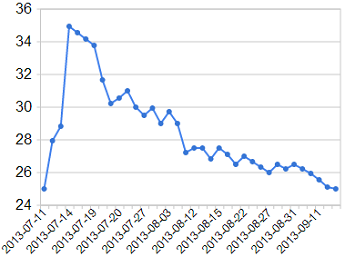
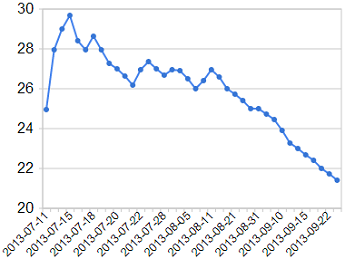
As for Vexing Devil, Avacyn Restored is a very weird set that behaved unlike every other Magic set in recent years in terms of value. There are also always a few casual cards so beloved they escape any sort of price drop at all—we’ve dealt with several of them in this article so far.
If Ryan’s theory were true, we would have seen the casual all-stars in Return to Ravnica block hold their presale values far more than they actually did. Remember Aurelia, the Warleader? She is arguably the most beloved Boros casual card of all time and is far and away the best red and white commander. She’s even a mythic in a winter set. Right now, she’s just $5. Granted, I love her as a long-term pick-up, but that’s after coming down about 300% since Gatecrash preorders went live.
So what’s going on here? Why is Aurelia down to $5 when older, worse cards are far more expensive? Surely if the casual community has grown along with the player base, demand for cards like this has risen along with supply, right?
Well, not exactly. Remember at the start of this article when I said that all casual players like different cards and strategies? This means that niche cards hit their saturation point—the place where supply outstrips demand—far quicker than competitive cards do.
At FNM tomorrow, you’ve got an equal chance of opening Thoughtseize and Prophet of Kuphrix. If you open the former, you can probably trade it to whomever you want—a ton will have to be opened before supply meets demand. If you open the latter, two or three players might really want a copy, but everyone else will be uninterested. Before long, the Prophets in a given store will quickly outnumber the interested parties.
Considering all of this, here’s my current approach to casual Magic:
- Trade away all brand-new casual cards as quickly as possible. I consider these to be binder poison and will trade them for other things at a loss if needed. Vexing Devils and Avacyns come around once in a while, but they are true exceptions to the rule. All other casual cards—especially non-mythic rares—will drop massively over the next few months.
- Immediately sell casual cards that are confirmed spoiled as a reprint. You will always have a chance to buy these again cheaper. The only exception is as a one-of rare in a Planechase deck or something, which don’t tend to move the needle much.
- Buy casual specs in August either one or two years from release. This depends on how good the prices are. For example, I bought Prime Speaker Zeganas last month because it was already very low. I’ll be buying Obzedats next August because Standard playability is still affecting the value of the card.
- Trade away causal cards whenever possible. The casual market is much more fractured, so it’s harder to find an interested party for any random card. It’s much easier to move a competitive staple.
- Pay close attention to casual staples that don’t drop at all. Once in a while, you get a card so beloved that it doesn’t go down in price at all. When you notice this—usually three months or so out from being spoiled—target it hard in trade. These cards tend to do nothing but rise in value for years.
Theros Gainers and Losers – Week #1
Keep in mind that I’m writing this article before this weekend’s tournaments. Based on those results, many of these prices may shift considerably.
Rising Stock
- Elspeth, Sun’s Champion – Up $10 from $29.99 to $39.99
- Stormbreath Dragon – Up $5 from $24.99 to $29.99
- Anger of the Gods – Up $3 from $2.99 to $5.99
- Sylvan Caryatid – Up $3 from $4.99 to $7.99
- Heliod, God of the Sun – Up $2 from $9.99 to $11.99
- Fleecemane Lion – Up $2 from $7.99 to $9.99
- Hero’s Downfall – Up $1 from $4.99 to $5.99
- Mistcutter Hydra – Up $1 from $2.99 to $3.99
- Steam Augury – Up $1 from $2.99 to $3.99
Falling Stock
- Swan Song – Down $1 from $5.99 to $4.99
- Prognostic Sphinx – Down $1 from $1.99 to $0.99
- Celestial Archon – Down $0.50 from $0.99 to $0.49
- Psychic Intrusion – Down $0.50 from $0.99 to $0.49
With zero tournaments under our belt, Theros is still all upside. I guarantee you that this week marks the highest overall value that this set will ever have. This is pretty common—sets normally rise in price all through the preorder period, peak on release weekend, and start falling off once cards actually make into the hands of players and some of those sweet spells start failing to pan out.
Pay especially close attention to supporting cards in whatever archetypes win this weekend. If blue devotion does well, look to buy Nightveil Specter. If Purphoros flexes his muscles, perhaps Boros Reckoner will make some major gains. This is where a lot of the real money will be made.
Don’t read too much into any of the gainers yet. Elspeth and Stormbreath Dragon are the two hottest mythics out of the gate, and their prices are currently reflecting that hype. Heliod has moved a bit—not a surprise since he was the lowest-priced God—and you can expect further movement if he breaks out this weekend. Sylvan Caryatid, Fleecemane Lion, and Hero’s Downfall have reached what I believe to be their short-term ceilings barring a breakout performance.
Three of the four cards that fell in price are past and future bulk rares so don’t worry too much about them. Swan Song is the only notable card to drop, and I pegged that card in the $0.50-$2 range long-term so I’m not surprised. None of the mythic rare or chase card prices are going to drop until demand starts to taper off. That might be a week or two away still.
Spec Portfolio – Week #6
With a month and a half gone, I feel good about having identified the bottom of the market. While most of my low-value casual flier specs haven’t done much, almost all of my Standard specs have paid off—some of them quite nicely. StarCityGames.com Back To School Sale ends the day that this article runs, which means you will see some sales (and new purchases) starting next week.
The biggest mover of the week? Jace, Architect of Thought moving from $15 (but sold out) up to a whopping $25. I will be selling this card next week unless it puts up massive results over the weekend—the profit on my $10 buy-in is all but assured. Supreme Verdict and Desecration Demon have both hit what I believe to be their short-term ceilings as well, especially with Detention Sphere showing up in the Event Deck.
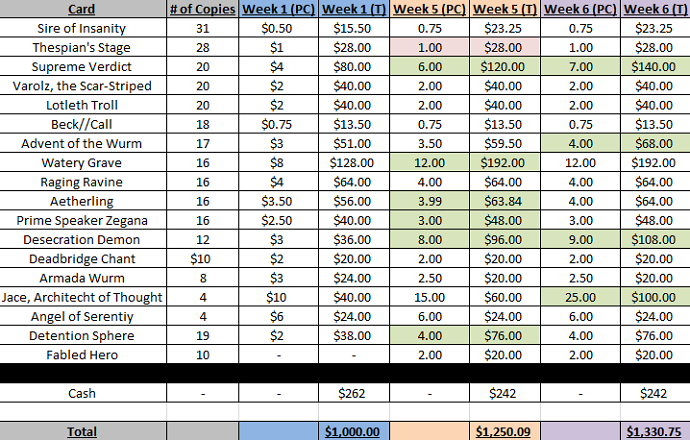
The best news of the week? We’re finally profitable! If I sold everything this week for current retail value minus the 25% fee I’m docking myself, I’d be $58.50 in the black.
Until next time –
– Chas Andres

